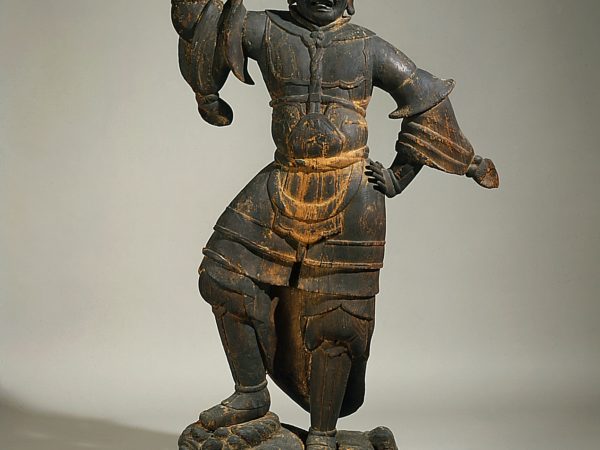Background Information
Video
Guardian King of the West
In this video, Buddhist monk artists, Seol-min (formerly known as Jae-u) and Myung Chun discuss Korean Buddhist art and paint the Guardian King of the West, which is now in the Asian Art Museum’s collection. This video also includes footage from a symbolic “eye-opening” ceremony, which took place at the museum on December 20, 2003.
Artwork
Guardian King of the South and Buddhist Guardian King of the East, approx. 950-1000
Virudhaka (Japanese: Zochoten), Buddhist Guardian King of the South and Dhritarashtra (Japanese: Jikokuten), Buddhist Guardian King of the East. Heian Period (794-1185), approx. 950-1000. Japan. Wood and pigments. The Avery Brundage Collection, B6S318+.
Video
GRAINS a performance by Surabhi Saraf and Ian Smith-Heisters
GRAINS is an original audio-visual performance deals with expanding the sonic energy that resides in a single grain of sound. The performance explores the visual and sonic amplification of domestic food grains and their transformation into a collection of solid grains that flow like liquid as they multiply. Layering her vocals on top of the flowing grains, Surabhi Saraf weaves a rich tapestry of sounds, multiplied and fragmented, creating dynamic textures and immersive architectural soundscapes.
Artwork
Gourd-Shaped Incense Container, 1625–1675
Gourd-shaped incense container, 1625–1675. Attributed to Nonomura Ninsei (active 1625–1675). Japan; Kyoto. Kyoto ware, stoneware with underglaze iron-oxide decoration. Museum Purchase, B74P5.
Video
Gold Dolt
Farnoosh Fathi reads a poem she wrote in response to the artwork, “Untitled 1 (Peacock with Missiles),” 2010 by Adeela Suleman. This work is in the exhibition Phantoms of Asia: Contemporary Awakens the Past (on view at the Asian Art Museum from May 18–September 2, 2012). For more information: This presentation was part of MATCHA.
Artwork
Goddess and Buffalo Demon
This Goddess image appears in a niche on one side of the main structure of the great Shiva Nataraja (Dancing Shiva) a temple in Chidambaram, in the southern state of Tamil Nadu. Learn more.
Video
Ghosts and Golden Clouds
In Noh theatre (classical Japanese music drama), Japanese ghosts are usually upset females. Portrayed without feet because they have lost their connection to the earth, they are so filled with love, jealousy or rage that they won’t go peacefully into the night. Japanese believe ghosts are people who have died with an unpaid on — “debt” or “obligation.” If not repaid, the debt is passed down for generations, growing with each one like a snowball into an avalanche.
Background Information
An Introduction to the Geography of Japan
Part of a long archipelago off the eastern rim of the Asian continent, the island country of Japan has four main islands: Hokkaido, Honshu, Shikoku and Kyushu. Learn more.
Video
Genji Ukifune
Kabuki scholar Laurence Kominz discusses a woodblock print of a Kabuki actor and courtesan depicted in a scene from the famous Japanese epic The Tale of Genji.

